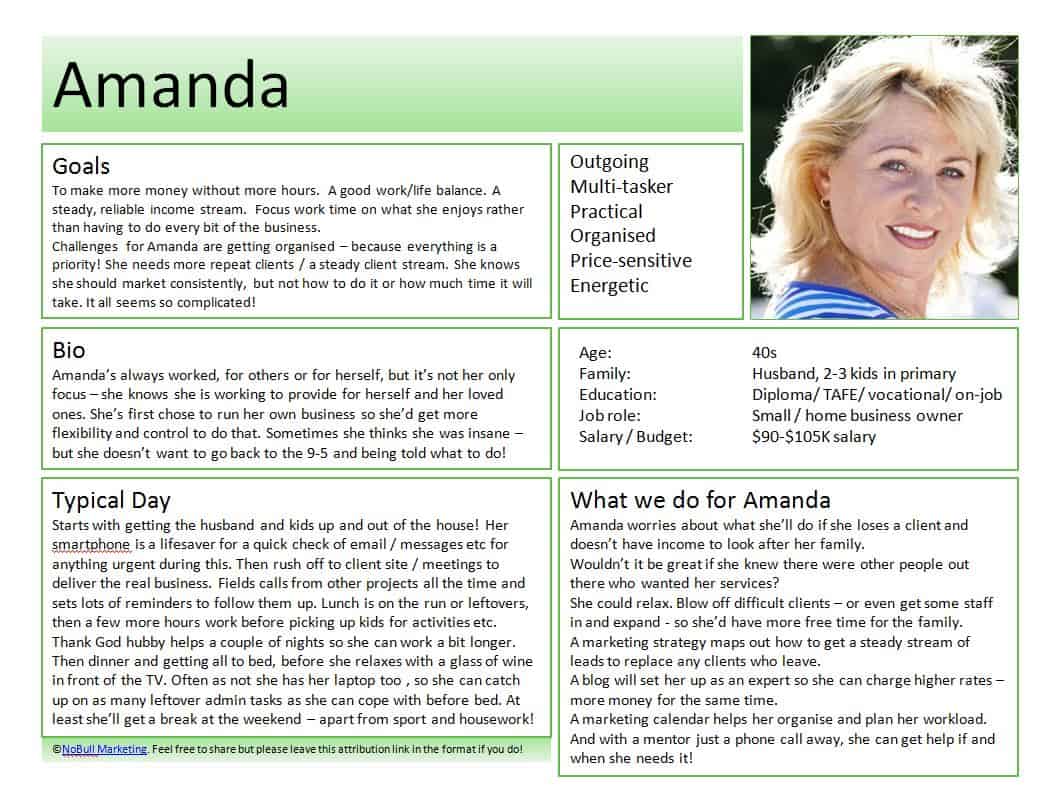How well do you know your target market?
How well do you know your ideal customer?
The questions sound really simple. Of course you know your target market. But do you? Or are you just making assumptions? Because you could be leaving a lot of business on the table. Even if you think you’re doing OK.


Let’s use my experience at RSVP as an example. Over two years we developed our understanding of the target market through three stages:
- Assumed demographics
- Data-driven demographics
- Psychographics and personas
Every improvement in understanding and communicating with the target market improved results.
Here’s the story.
Stage One – Assumed Demographics
I took over at RSVP two to three years after it started. (For anyone who doesn’t know, RSVP is an online dating site – privately owned when I was there, then sold to Fairfax for around AU$40 million soon after I left.)
The business was successful and growing fast. It was a marketing-focused business, with a need to grow its database. And the accepted target market was single women aged 18 to 30.
Why? Here’s the thinking.
- When it comes to dating, men go where the women are. So if we get lots of women on the site, lots of men will join too. They’ll pay to reach out and contact the women.
- So we need to get women on the site, but which women? We need women who will attract men. And that’s the cute, pretty 18 to 30 year olds. (Everybody wants somebody gorgeous, after all!)
That’s the assumed target market I inherited when I started. It was fairly sophisticated logic, and it certainly wasn’t completely off the mark. As I said the business was growing very successfully.
Stage Two – Data Driven Demographics
But I challenged the assumptions. It may have been because I was female and I looked at dating differently from the men who had run the company. It may have been because I love data. I just wanted to test the assumptions.
Luckily for me, we had lots of data! We were an internet dating site – members had completed profiles. Even better, they had completed profiles for who they wanted to meet. I said, “Well, let’s have a look at data and let’s just test our assumptions. See if that’s the reality.”
The first question we looked at was who our paying members were.
What did we find?
- A third of our revenue came from women reaching out to contact men. That was a revelation. It made the market much more complicated and interesting.
- The vast majority of our revenue came from members over the age of 30.
- In fact, even though men spent 70% of the money online, men under 30 spent less than women over 30. The women under 30 spent even less than men their age – they hardly spent at all.
Think about the implications. In terms of paying customers, our markets ranked as follows:
- Men over 30
- Women over 30
- Men under 30
- Women under 30
In other words, age mattered more than gender!
Essentially our market was all people who were over 30. That was the first great insight. It was quite different from the starting assumption that men pay to reach out and contact women.
Then we asked a second question. Now we know who our best paying members are, who are the people they want to meet? What’s the ideal profile to get on the site?
As I said before, we had data about members’ ideal partners. So we analysed that.
For this exercise, we focused on our financial sweet spot – men aged 45 to 55. And here’s what we found.
- The average man over the age of 40 is not looking for a sugar-baby under the age of 30.
- He actually wants someone in the age range 28-35.
(Women, there is some hope. Men, you’re not all bad. Although there’s still some age gap to contend with!)
We shifted our targeting from 18-30 women. Focused on the 25-45 age group instead.
You might notice that age range finishes a bit higher than the desired age of our older men. Well spotted! But remember older women were our second best paying demographic. So they were worth targeting in their own right, not just to attract men.
At this point, we had moved from an assumed target market to a data-based, demographic target market. That’s stage two in getting to know your target market.
Stage Three – Psychographics and Personas
 The demographics gave us a lot of help in telling us who to target and how to reach them. What channels to use. But how were we going to persuade them to try RSVP?
The demographics gave us a lot of help in telling us who to target and how to reach them. What channels to use. But how were we going to persuade them to try RSVP?
Demographics didn’t tell us a great deal about what message to use.
We needed to look beyond demographics. To psychographics.
Psychographics:
market research or statistics classifying population groups according to psychological variables (as attitudes, values, or fears);
also variables or trends identified through such research
So what values, attitudes or fears could we address in our marketing message?
The first and most obvious thing to point out is that not all 25-45 year old women are the same. (If they were, we wouldn’t need sites like RSVP!)
Let’s make it human, let’s talk about real women. Me, for one. My marketing manager from RSVP, for another. At the time I’m talking about, both myself and my marketing manager were single females over 28 and under 35. Both slap bang in our target market, but we were really, really, different people.
- I’d come to Australia in a relationship with a partner, lived in the suburbs with a man who had a young son, met lots of other couples with children, then split up. I didn’t know many single people in Sydney. I didn’t have a huge social network. I had no children so I could still go out at night, but I didn’t know lots of people to do it with. Plus I’d never really liked clubbing anyway. I’d rather be in a smaller group and talk.
- My marketing manager on the other hand had grown up in Sydney, had been in a number of relationships but not such serious ones. She was a little younger than me. She was a party animal. She knew a million single people. There was always somebody she could go out with, and she pretty much always wanted to go out.
Think like a marketer. What kind of message would persuade me to try an internet dating site? And what kind of message would persuade my marketing manager?
For people like me, there’s a whole set of messages about how internet dating is safe, convenient, and easy. How it gives me a better insight into the person (people!) I’m in contact with.
- If you’ve got no one to go out with you can still meet people.
- You don’t have to get dressed up and drink loads of alcohol. It’s not going out and partying with lots of drinking, loud music and shouting to be heard.
- You can find out much more about the people you contact. You have time to think about their words and what they say, not just what they look like. You can meet somebody in your own time. Go at a pace which suits you.
- It’s actually safer than going out to a bar on your own. You’re at home, behind locked doors. They can’t reach you. It’s not like somebody can follow you home on the train, or you have to pay for a ridiculously expensive cab.
What about my marketing manager? Most of those messages don’t apply to her life at all. She’s much more interested in partying. Fun. Fashion. The latest trends. (She brought us Krispy Kreme donuts in for the team when they were so new I’d never heard of them.) So for her the messages were different.
- Internet dating is the latest thing. Trendsetting.
- It’s edgy. Not sleazy, but sexy. (A hard differentiation, but that’s another story!)
- If you do end up with a sleazebag, it’s easier to get rid of him. (The ‘block’ functionality.)
- At the very least, it’s good for a laugh. Try it with your girlfriends. (We got a lot of women members by referral.)
There was one other group we targeted. Single mothers. For them, the challenges of traditional dating were huge, and internet dating offered a great alternative.
- If you think a night out on the town’s expensive, try adding the cost of a babysitter!
- No worrying about who’s looking after the kids – you can just go online once they’re in bed.
- Less awkward telling potential partners you have children. They can see it on your profile.
- Screen out people who will be put off by your children.
Personas
What I want to point out here is that even when demographics like age and gender are the same, the kind of person you’re targeting makes a huge difference to how you market. To your messages.
And that’s where personas come in.
In marketing terms, a persona is ‘a semi-fictional representation of your ideal customer based on market research and real data about your existing customers’. (Thanks, Hubspot!)
At RSVP, we had three key personas. A social butterfly. A quiet type who didn’t like the dancing and clubbing dating scene. And a single mum who was stuck at home a lot. Those personas were much more helpful in developing our marketing message than demographics!
And to make it easier for us, two of those three personas were walking around the office. Directing the company and the marketing. That certainly helped us get the marketing messages right.
Actually, half the office was single. Men and women. We ran marketing ideas past all of them. Feedback is a wonderful thing. Free feedback before committing the cash is even better!
But personas weren’t enough alone. Many of our paid advertising options had no personas, not even a very clear idea of their ideal customer. But they all had documented, verified demographics.
We used demographics to pick our marketing channels and personas to develop our marketing message.
So our message was relevant to the people most likely to sign up, use, enjoy and endorse our service.
And the result?
In two years, we tripled revenues and overtook the competition to become number one for internet dating in Australia.
That’s what intelligent marketing, continually getting to know your target market better, can deliver.
Can this marketing approach work for you in your business?
My story’s a B2C example, and many of you are probably in B2B businesses.
But a clear understanding of your target market is just as important in B2B as in B2C. And getting to know your target market is likely to go through the same stages. (Although the faster you can progress, the better!)
Personas are just as important in B2B too. You construct them in the same way. You just focus them differently. Check out this one we’ve shared here – Amanda. (Is it you? You are one of our target personas – I hope!)

Your persona is a fully rounded human being that you’d like as a client, so you’re still interested in their personal life, their family, their friends, all that kind of thing. But not as interested. You focus more on their work personality, and you have to ask some different questions to understand how they function and act at work. How do you develop a persona? Research, analysis and interviews. Basically, you do a lot of thinking and ask a lot of questions. Research with data and with real people. My next post is going to focus on exactly this process. But if you want to start right now, you can also download the persona template we use here at NoBull Marketing and apply it to your own business.
get in touch and we can work together to identify your target market and narrow down your ideal customer.






